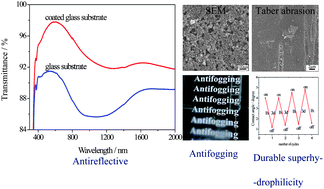Fabrication of mechanically robust films with high transmittance and durable superhydrophilicity by precursor-derived one-step growth and post-treatment†
Abstract
In this study, we developed a novel approach to the fabrication of mechanically robust films with high transmittance and durable superhydrophilicity. First, precursor-derived one-step growth (POG) was used to fabricate ordered nanoporous silica films, and the thin film surface was then coated with one layer of SiO2 nanoparticles and one layer of TiO2 nanoparticles by dip-coating. After calcination at 550 °C and hardening at 720 °C, the obtained films exhibited not only high transmittance and low reflectivity, but also durable superhydrophilicity and good mechanical robustness. The maximum transmittance of the coated substrates reached as high as 97.8%, while the control glass substrate achieved only 91.4%. Scanning electron microscopy (SEM), transmission electron microscopy (TEM) and atomic force microscopy (AFM) were used to observe the morphology and structure of the nanoparticles and coating surfaces. Optical properties were characterized by a UV-visible-near IR spectrophotometer. Surface wettability was studied by a contact angle/interface system. The current approach may open a new avenue to practical applications in windshields, eyeglasses, swimming goggles, periscopes, lenses in laparoscopes, windows of high rise buildings and solar cells, etc.


 Please wait while we load your content...
Please wait while we load your content...